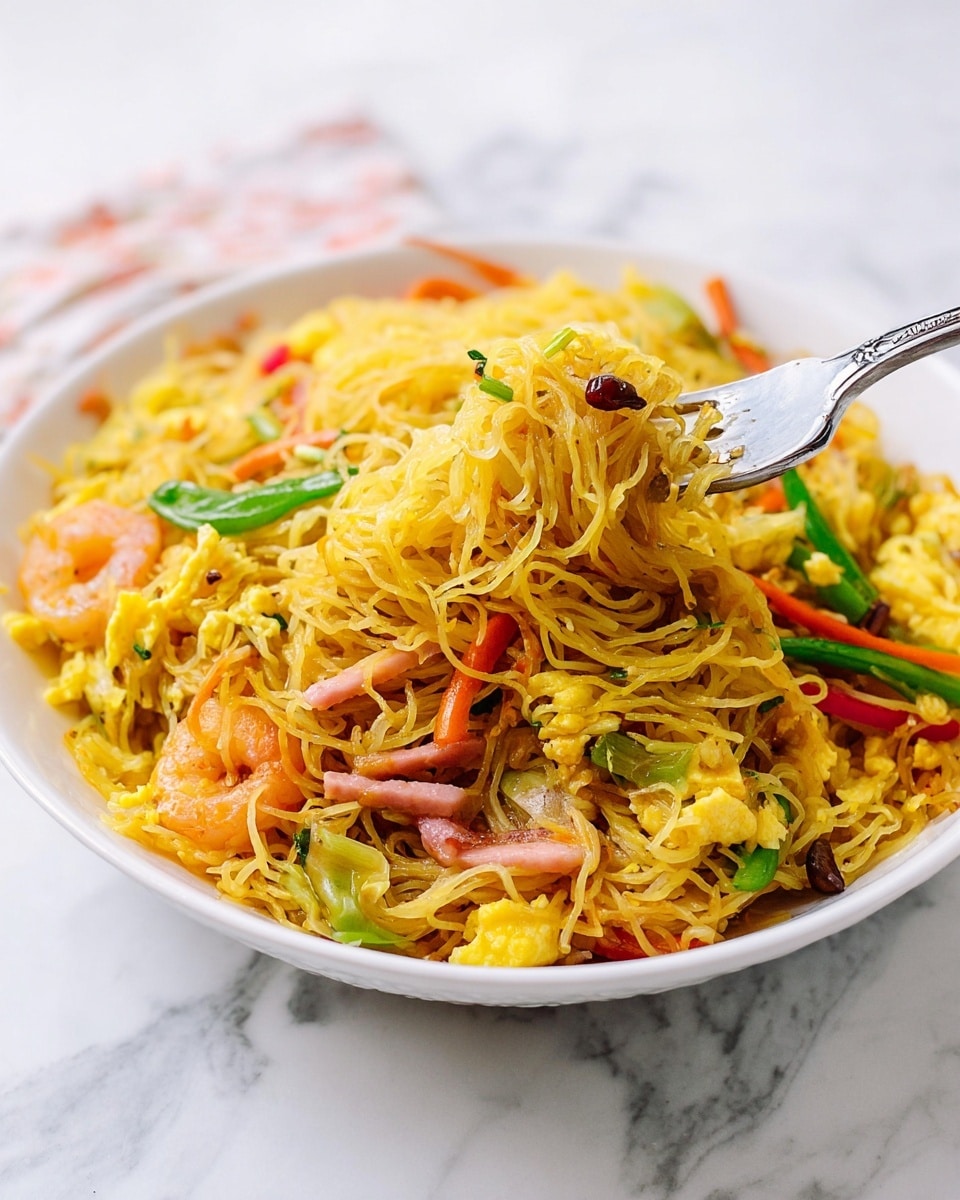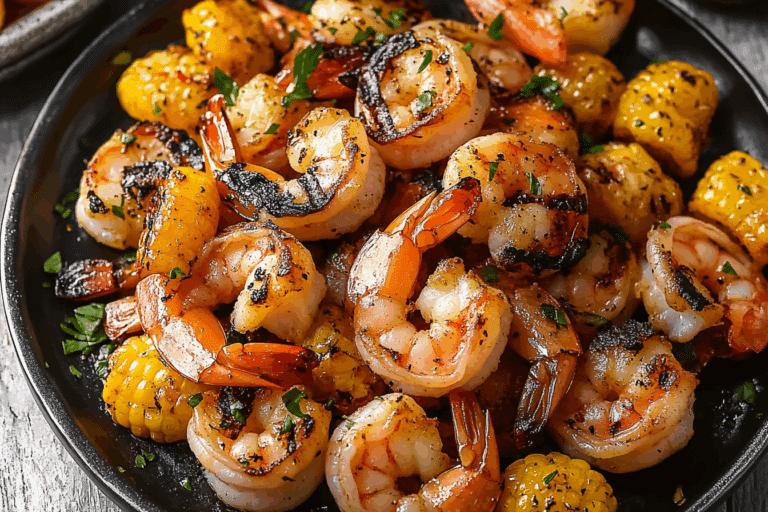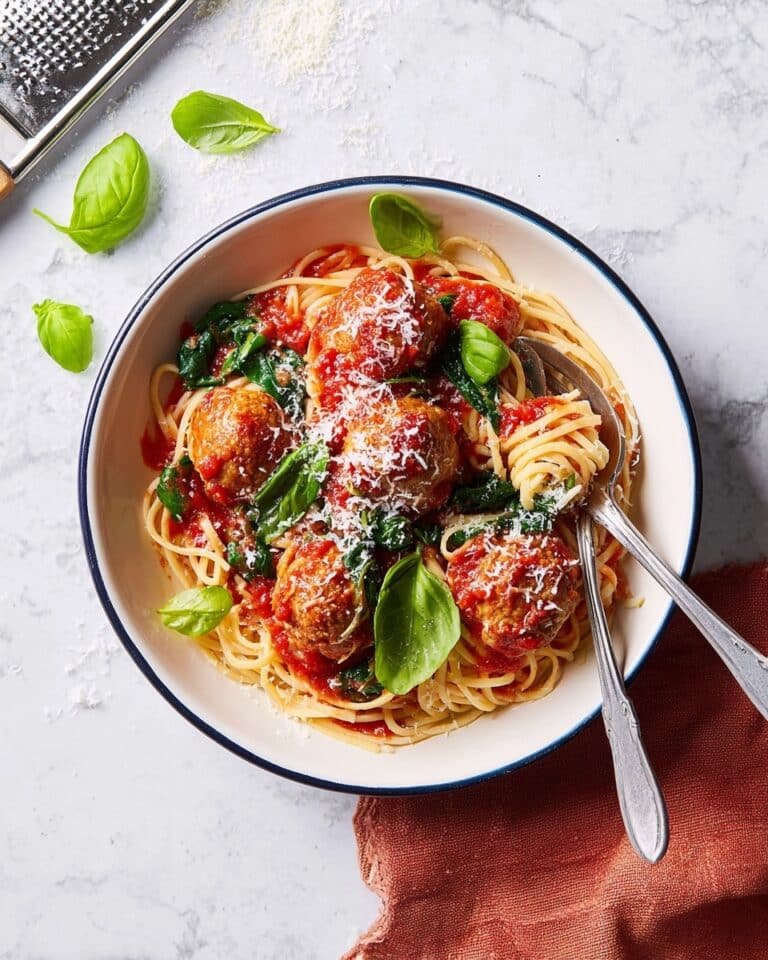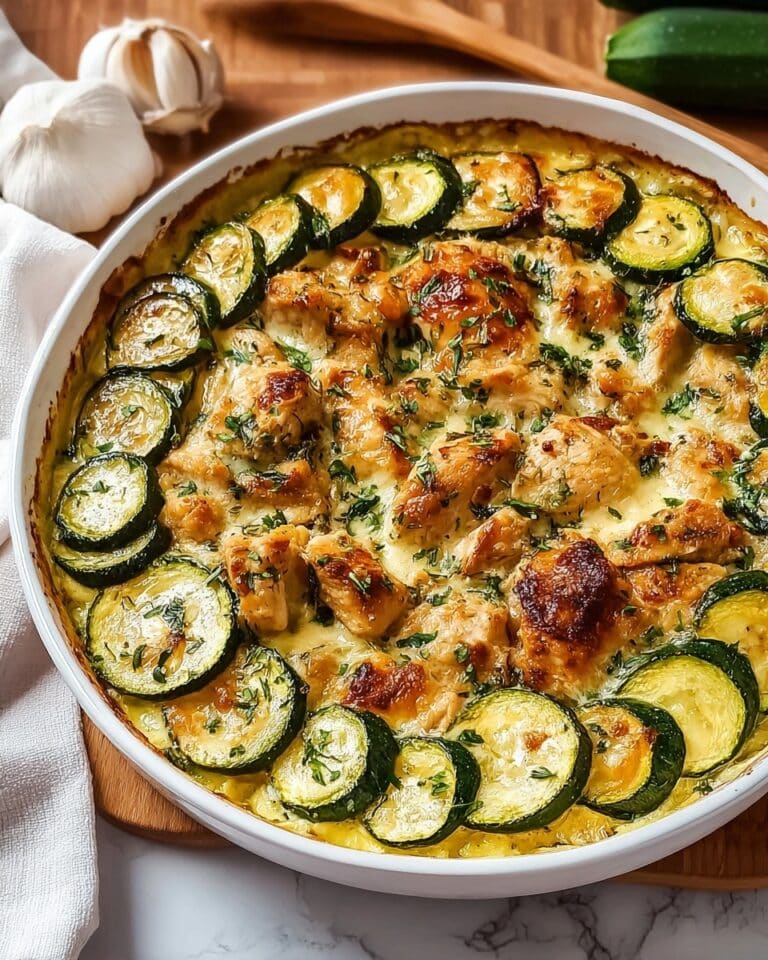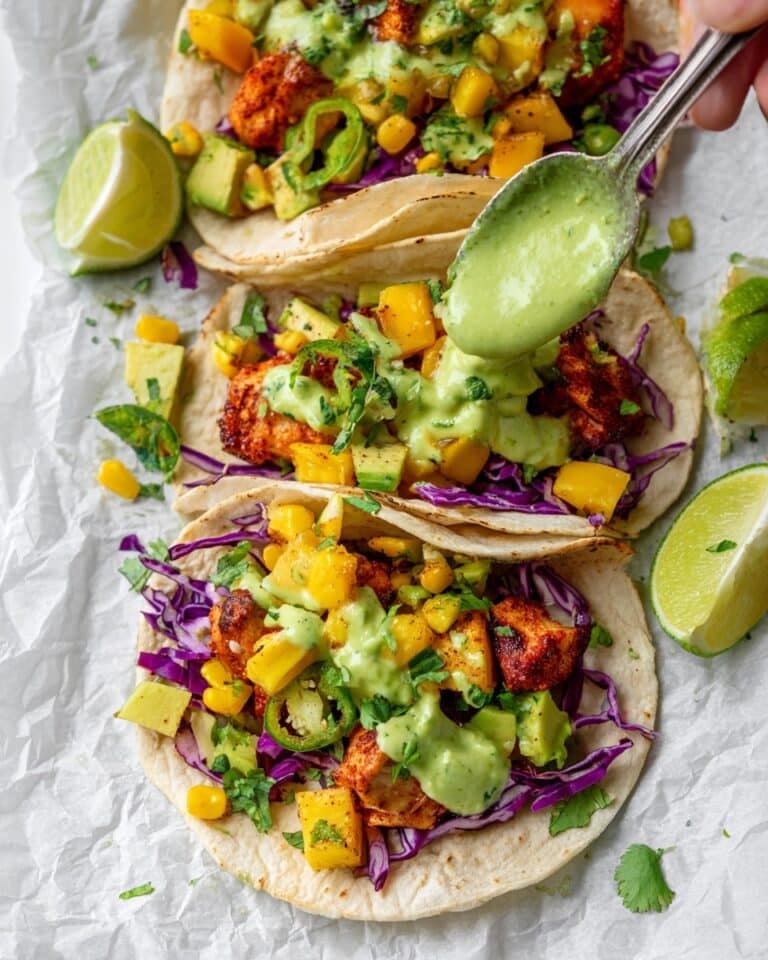Singapore Rice Noodles Recipe
If you’ve ever craved that perfectly fragrant, colorful stir-fry you find in Asian restaurants, the Singapore Rice Noodles Recipe is exactly what you need in your home kitchen. I love how this dish dazzles with its bold, curry-infused flavors and the way it brings together shrimp, tender roast pork, and crisp veggies in every bite. It’s a dish that feels special enough for guests but simple enough for a weeknight dinner.
What makes this Singapore Rice Noodles Recipe so worth trying is its wonderful balance of spices and textures — the noodles are silky, the curry powder adds just the right warmth, and the handful of fresh vegetables keeps it vibrant and light. Plus, it’s forgiving if you want to swap ingredients or adjust the spice level. Trust me, once you get this recipe down, you’ll find yourself turning to it again and again.
Ingredients You’ll Need
The magic of this recipe lies in using fresh, simple ingredients that layer flavors beautifully when cooked together. Don’t worry if you can’t find everything at once—Asian markets typically have the rice noodles and curry powder, but many stores carry them nowadays, too.
- Shrimp: Peeled and deveined shrimp add that lovely seafood sweetness; fresh or frozen works fine, just make sure to rinse well.
- Canola or vegetable oil: Neutral oils help fry everything evenly without overpowering flavors.
- Asian fish sauce: It’s the umami powerhouse here—adds depth and a subtle saltiness.
- Dried rice stick noodles: Also called rice vermicelli; soak them in warm water before cooking to get that silky texture.
- Garlic: Freshly minced garlic is key for that classic fragrant base.
- Curry powder: Pick a good quality curry powder; I like mild to medium heat to let the other flavors shine.
- Soy sauce: Adds savory notes and balances the curry spices.
- Shaoxing wine: This Chinese cooking wine gives authenticity and that slight tang; you can substitute dry sherry if needed.
- Ground white pepper: Offers a mild heat without adding black specks in the dish.
- Sugar: Just a pinch balances the savory and spicy flavors.
- Eggs: Beaten and salted, they create delicious ribbons of soft texture throughout.
- Chinese roast pork (char siu) or ham: This brings a smoky-sweet depth; char siu is ideal if you can get it.
- Onion: Thinly sliced for a slight sharpness and crunch.
- Red bell pepper: Julienne for color and sweetness.
- Snow peas: Thinly sliced on the bias to maintain crispness and brighten the dish.
- Carrot: Julienne for sweetness and crunch.
- Kosher salt: To taste, seasoning everything just right.
- Scallions: Thinly sliced for a fresh, oniony finish.
- Toasted sesame oil: Added at the end for that irresistible nutty aroma and flavor.
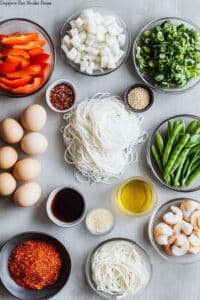
Variations
I like to switch things up based on what’s in my fridge or who’s coming to dinner — this is one recipe that’s perfect for personalization. It’s your canvas, so feel free to add or swap ingredients to suit your tastes and dietary needs.
- Vegetarian version: I’ve swapped shrimp and pork for tofu and extra veggies like baby corn or mushrooms, and it still packs a punch of flavor.
- Spice it up: When hosting friends who love heat, I sometimes add chili flakes or fresh sliced chili to give that extra kick.
- Protein swaps: Chicken strips, firm tofu, or even thinly sliced beef make great alternatives if you want a different twist.
- Gluten-free option: Ensure your soy sauce is gluten-free or replace with tamari, and you’re good to go.
How to Make Singapore Rice Noodles Recipe
Step 1: Prepare Your Ingredients and Noodles
Before you heat up any pans, soak your dried rice stick noodles in warm water for about 20-25 minutes until they’re soft but still a bit firm to the bite; then drain well. While those soak, slice your pork and veggies, peel and devein shrimp if you haven’t already, and beat the eggs with a pinch of kosher salt. Having all your mise en place ready is key to a quick, smooth stir-fry.
Step 2: Cook the Eggs and Shrimp
Heat 2 teaspoons of oil in a large wok or skillet over medium-high heat. Pour in the beaten eggs, swirling to create thin ribbons. Once set, remove and set aside. Next, add a little more oil and quickly sauté the shrimp until they just turn pink. Don’t overcook! Remove and set aside with the eggs.
Step 3: Stir-Fry Aromatics and Pork
Add 3 tablespoons of oil to the wok, then toss in the garlic and half of the curry powder. Stir constantly for about 30 seconds to bloom those spices—you’ll smell that fantastic curry aroma filling your kitchen. Quickly add the sliced pork, onion, and bell pepper; sauté until veggies start to soften but still hold some crunch.
Step 4: Bring It All Together
Throw in the snow peas, carrots, soaked noodles, shrimp, and eggs. Splash in the fish sauce, soy sauce, Shaoxing wine, white pepper, sugar, and the other half of your curry powder. Turn up the heat and toss everything vigorously so the noodles get nicely coated in the sauce and the ingredients heat through evenly. Remember to taste and add salt if needed — this is your chance to perfect the balance!
Step 5: Finish with Fresh Touches
Just before taking the wok off the heat, stir in the sliced scallions and drizzle the toasted sesame oil over everything for that final burst of flavor and aroma. Give it one last toss, then serve immediately.
How to Serve Singapore Rice Noodles Recipe
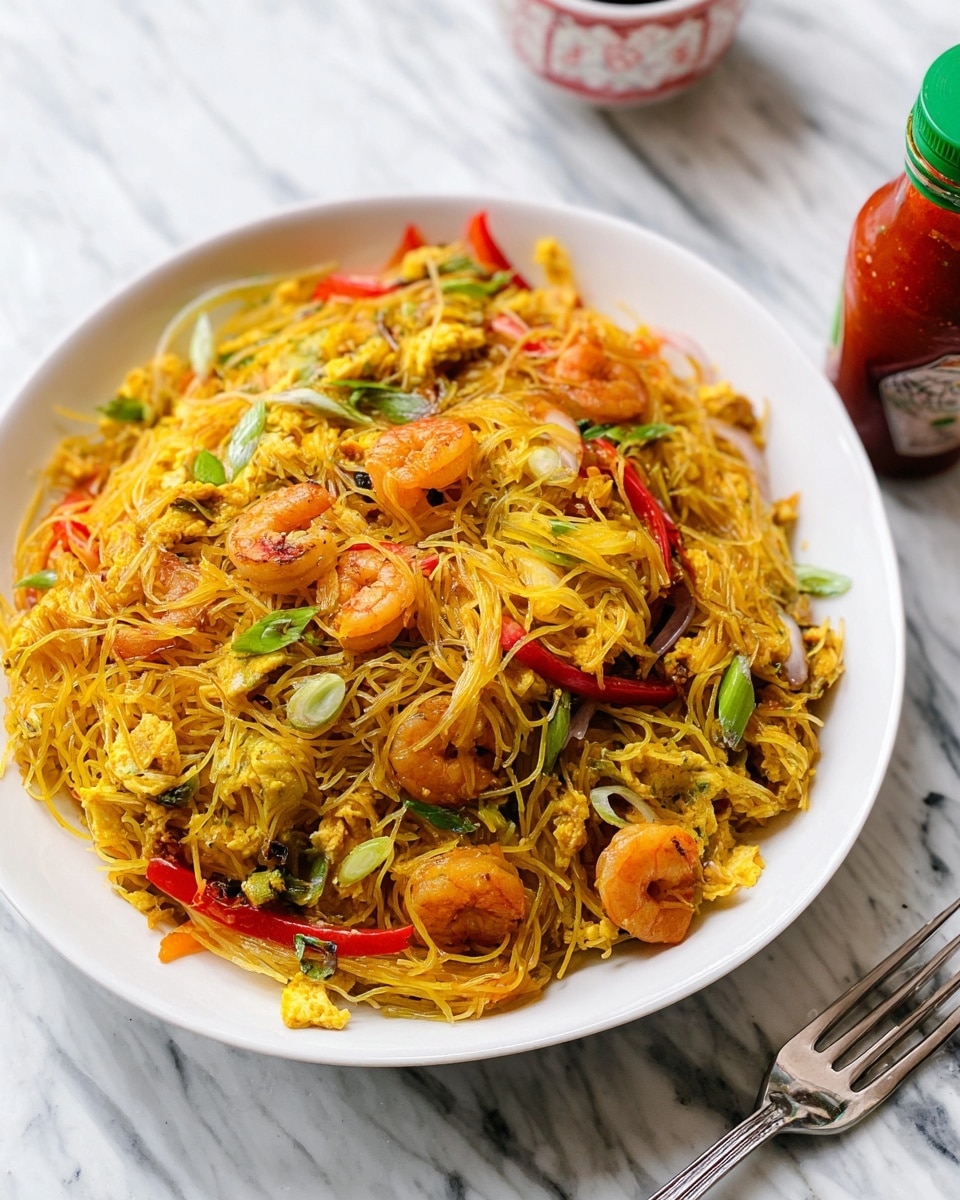
Garnishes
I usually top my noodles with extra sliced scallions and a few cilantro leaves if I have them on hand. A wedge of lime on the side adds a refreshing zing when squeezed over. Sometimes, I keep some chili oil nearby for friends who want to add some heat themselves — it’s all about that personalized touch!
Side Dishes
Pairing this dish with some lightly pickled cucumbers or a simple miso soup really rounds out the meal well. I’ve also enjoyed it alongside crispy spring rolls or a fresh green salad with ginger dressing for a complete Asian-inspired feast.
Creative Ways to Present
For special occasions, I love serving the Singapore Rice Noodles in individual bamboo steamers or pretty bowls garnished with edible flowers and toasted sesame seeds. It’s a nice way to impress guests while keeping things authentic and fun!
Make Ahead and Storage
Storing Leftovers
Leftover Singapore rice noodles store well in an airtight container in the fridge for up to 3 days. I like to separate any extra sauce from the noodles if possible to avoid sogginess. When you’re ready to eat, just reheat gently to bring it back to life.
Freezing
I don’t typically freeze this dish because the veggies and noodles change texture when thawed. If you must freeze, do so without the fresh scallions and sesame oil, adding those fresh after reheating for best results.
Reheating
To reheat, I prefer tossing leftovers in a hot pan with a splash of oil over medium-high heat, stirring frequently until warmed through. Microwave works in a pinch but can make the noodles a bit mushy, so stirring well and adding a little water or oil helps.
FAQs
-
Can I use fresh rice noodles instead of dried in this Singapore Rice Noodles Recipe?
Absolutely! Fresh rice noodles can be used and they actually cut down your prep time since you don’t need to soak them. Just be careful when stir-frying because fresh noodles are more delicate and can break apart if over-stirred.
-
What’s the best way to get the curry flavor to really shine without overpowering the dish?
Using a good quality curry powder and splitting it up between the initial aromatics and the final stir-fry step helps the flavor develop fully and integrate smoothly. Don’t add too much at once — start with less and adjust as you go, tasting along the way.
-
Can I make Singapore Rice Noodles Recipe vegan?
Definitely! Simply skip the shrimp and pork, replace the eggs with scrambled tofu or omit completely, and use soy sauce instead of fish sauce to keep it vegan-friendly. Load up on veggies for flavor and texture.
Final Thoughts
Honestly, this Singapore Rice Noodles Recipe has become one of my go-to comfort meals when I want something quick yet impressive. Its combination of vibrant colors, fragrant curry, and satisfying protein and veggies hits all the right spots — and I know you’ll enjoy making it your own in the kitchen. So next time you’re craving a restaurant-worthy dish without the fuss, give this a try and watch it become a family favorite.
Print
Singapore Rice Noodles Recipe
- Prep Time: 25 minutes
- Cook Time: 15 minutes
- Total Time: 40 minutes
- Yield: 4 servings 1x
- Category: Main Dish
- Method: Stovetop
- Cuisine: Singaporean
Description
Singapore Rice Noodles is a vibrant and flavorful stir-fried noodle dish featuring tender shrimp, savory Chinese roast pork, crisp vegetables, and a fragrant blend of curry powder and seasonings. This quick and delicious recipe highlights thin rice stick noodles cooked to perfection and tossed with aromatic spices, eggs, and fresh scallions for a satisfying meal inspired by Singaporean street food tradition.
Ingredients
Proteins
- 1/4 pound shrimp, shelled, deveined, and rinsed under cold water
- 2 eggs, beaten with two pinches kosher salt
- 1/4 pound Chinese roast pork (char siu) or ham, cut into thin strips
Noodles and Oils
- 1 bundle (about 5 1/2 ounces) dried rice stick noodles
- 4 tablespoons plus 2 teaspoons canola or vegetable oil, divided
- 2 teaspoons toasted sesame oil
Seasonings and Sauces
- 2 1/2 teaspoons Asian fish sauce, divided
- 1 tablespoon curry powder, divided
- 1 teaspoon soy sauce
- 1 teaspoon Shaoxing wine
- 1/4 teaspoon ground white pepper
- 1/4 teaspoon sugar
- Kosher salt, to taste
Vegetables and Aromatics
- 2 medium cloves garlic, minced
- 1/4 medium onion, very thinly sliced
- 1/2 medium red bell pepper, stemmed, seeded and julienned
- 12 snow peas, stemmed, tough strings removed, and sliced thinly on the bias
- 1/2 medium carrot, julienned
- 2 scallions, sliced very thinly on the bias
Instructions
- Prepare the noodles: Soak the dried rice stick noodles in warm water for about 20 to 30 minutes or until they are pliable but still slightly firm. Drain and set aside to prevent them from sticking together.
- Cook the shrimp: Heat 2 teaspoons of the canola oil in a large skillet or wok over medium-high heat. Add the shrimp and a pinch of salt, and stir-fry until the shrimp turn pink and are just cooked through, about 2-3 minutes. Remove the shrimp from the pan and set aside.
- Make the scrambled eggs: Add another 2 teaspoons of oil to the pan. Pour in the beaten eggs and scramble gently until they are softly set but not overcooked. Remove from the pan and set aside with the shrimp.
- Cook aromatics and vegetables: Add the remaining canola oil to the pan. Sauté the minced garlic and thinly sliced onion over medium-high heat until fragrant and translucent, about 1-2 minutes. Then add the red bell pepper, snow peas, and carrot, stir-frying until just tender-crisp, about 2-3 minutes.
- Add seasonings and sauces: Sprinkle in half of the curry powder, ground white pepper, sugar, and half of the fish sauce. Stir well to combine flavors evenly. Add the soy sauce and Shaoxing wine then cook for another 30 seconds to meld the flavors.
- Combine noodles and proteins: Add the drained noodles to the pan, tossing gently to combine. Then add the cooked shrimp, scrambled eggs, and Chinese roast pork strips. Continue tossing the mixture gently to distribute ingredients without breaking the noodles.
- Finish with remaining seasoning: Sprinkle the remaining curry powder and fish sauce over the noodles along with a pinch of kosher salt to taste. Toss well to coat everything evenly with spices and sauce.
- Garnish and serve: Remove from heat and drizzle toasted sesame oil over the noodles. Toss lightly before garnishing with thinly sliced scallions. Serve immediately for the best flavor and texture.
Notes
- Soaking the rice noodles until pliable is essential to prevent breaking during stir-frying.
- Curry powder varies in intensity; adjust the amount according to your taste preference.
- If you cannot find Shaoxing wine, substitute dry sherry or omit it for a milder flavor.
- Make sure to use a large, nonstick skillet or wok for even stir-frying and to avoid overcrowding.
- This dish can be adjusted to vegetarian by substituting tofu for shrimp and pork, and using vegetarian fish sauce alternatives.
Keywords: Singapore Rice Noodles, Char Siu Noodles, Curry Rice Noodles, Asian Stir Fry, Shrimp and Pork Rice Noodles

